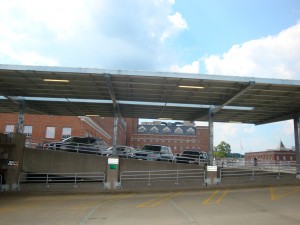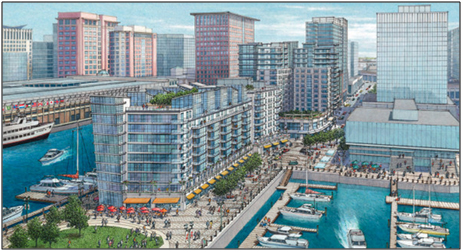New Jersey Future Blog
Why Not Tier Solar Incentives to Encourage Advantageous Locations?
August 24th, 2011 by Chris Sturm

Solar canopy on Morris County Administration parking garage
In testimony at today’s Energy Master Plan hearing, New Jersey Future highlighted ways in which the Board of Public Utilities might fine-tune the solar subsidies offered by the state.
Why not offer larger subsidies to solar installations that are located consistent with other state policy objectives, including not only brownfields and landfills, but also other impervious surfaces, such as rooftops and parking structures, that have few or no negative impacts on land preservation or redevelopment potential? In an industry driven by public-sector incentives, a tiered system could encourage more projects in the most advantageous locations.
While we expect solar facilities to continue to be sited on some combination of ground and rooftop, research done by New Jersey Future graduate student intern Jed Drolet suggests that there is likely to be more than enough rooftop space to meet the state’s long-term goals. Jed approached this question in two ways: First, he estimated the square footage of rooftop needed to meet the state’s solar development goals for 2026 and arrived at a figure of 327 million square feet — a fraction of the state’s total impervious surfaces, estimated at 22 billion square feet. Second, he looked at a national study that examined the solar output capacity of New Jersey’s commercial and residential rooftops, and found a total rooftop potential for New Jersey of over 9,000 mW — more than double the state’s goal for 2026.
Although both approaches apply assumptions across a broad area without detailed analysis, they suggest a great deal of additional potential for solar on rooftops. In other words, on the solar energy front, New Jersey is well-positioned to take advantage of being the nation’s most developed state.
















Great job NJ Future! Thanks for pointing out that high quality agricultural soils need not be wasted for solar “farms”.
Also the idea of a tiered incentives is absolutely brilliant! Makes WAY too much sense.
Jed should be commended for his work in identifying the supply side for solar development. The industry is well aware of the number of industrial roofs available alone to meet the anual RPS. However, the problem is not the supply side, it’s the demand side. NJ needs to make those roofs be attractive sites for solar development beyond net metering and utility grade connection by allowing for virtual net metering and community energy collaboratives. Tiered incentives work well with land use not energy production. With a maturing solar energy industry NJ is prepared to take the next step and be a leader for the nation.
Tony – interesting comment. Can you explain what you mean by net metering and community energy collaboratives, and why they are needed?
The NJ Pinelands Commission is scheduled to adopt new rules that would exempt new solar facilities that will be placed on existing impervious surfaces (e.g., roofs, parking lots, etc.) from applying to the Commission. We believe this is a significant incentive for just what you advocate.
That makes good sense…. if solar is on a rooftop, for example, it’s not really new development. If it’s on a parking lot, it won’t further impair stormwater runoff. Are you concerned, though, about surface parking lots in locations that have significant redevelopment potential, such as next to a train station? I do realize that such situations probably don’t arise nearly as often in the Pinelands as they might else where in the state…
Great idea. Make solar trees in the parking lot and recharge electric cars. good job.